2023 Preservation Projects
Since our establishment 160 years ago in 1863, Crown Hill Cemetery has been changing the original landscape by building amazing architecture designed by Indianapolis’ preeminent architects and by erecting tombstones for everyone from influential leaders to everyday hardworking Hoosiers. As you drive around the grounds, you see the impact this built environment has had on what makes Crown Hill Cemetery a special place.
As we look forward to what the next 160 years will bring, we know that preserving what is here is a must. The historic preservation of Crown Hill Cemetery is a cornerstone of the mission of the Crown Hill Foundation.
Each year, the Foundation embarks on various projects to preserve and restore mausoleums, cemetery buildings, monuments, statues, and pieces of art that are in need of repair. Our 160th year has been no different.
We continued our mausoleum work by cleaning, repairing and restoring three private family mausoleums: the Severin, the Frenzel/Dickson, and that of Carl Fisher. Some just needed a little cleaning and joint repair, while others required extensive repair work. See our mausoleum work on our Preservation page.
Severin Family Mausoleum
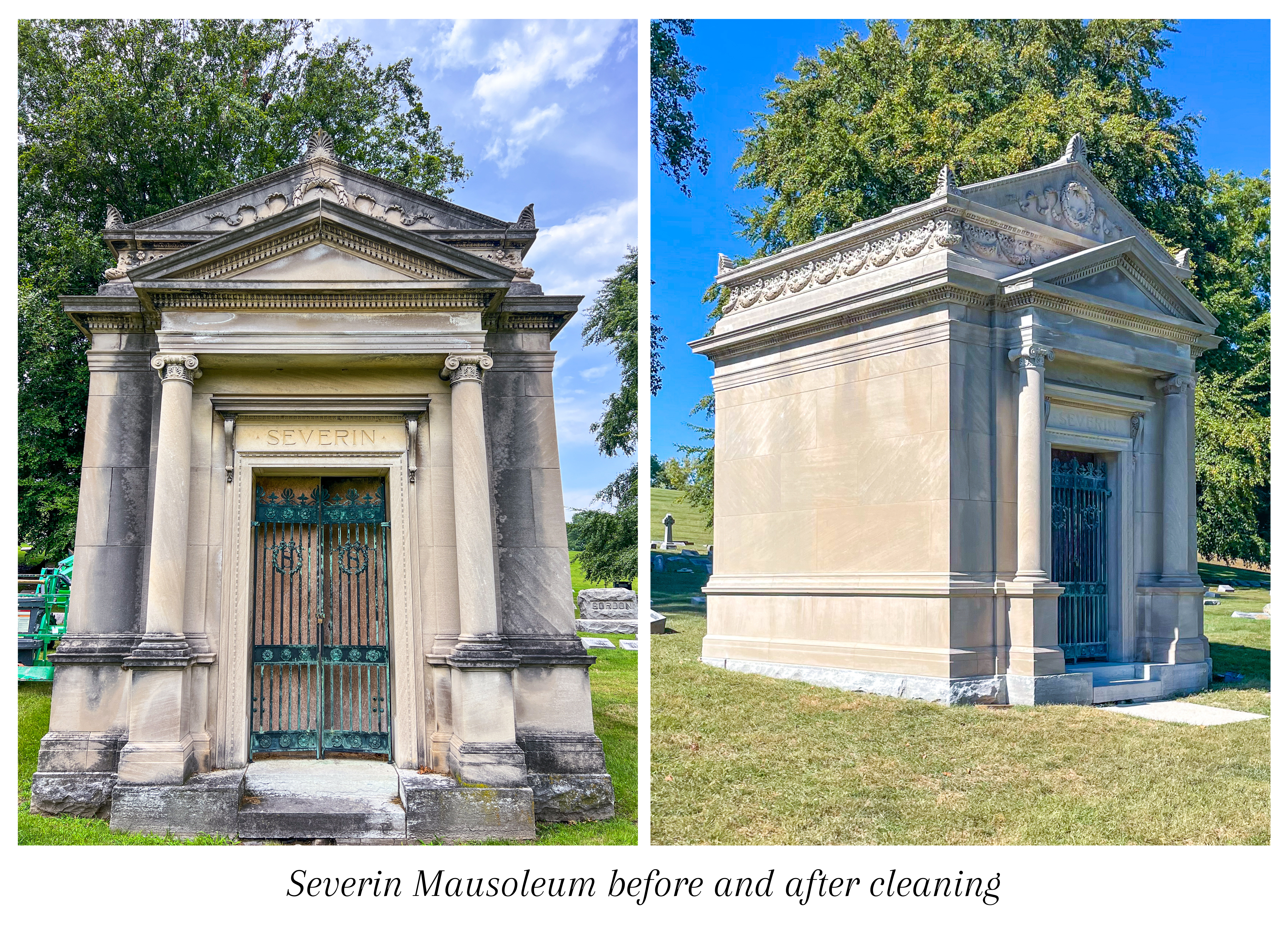 In 1913, with the help of Indianapolis Motor Speedway founders Carl Fisher and James Allison, Henry Severin built his hotel (now known as the Omni Severin) in downtown Indianapolis across the street from Union Station. The hotel was designed by the architectural firm Vonnegut and Bohn, which also designed the cemetery’s Sentry House next to the 34th St. Gothic gate. An interesting side note is that the Severin Hotel was listed in The Negro Motorist Green Book as a location where African Americans could stay when visiting the city.
In 1913, with the help of Indianapolis Motor Speedway founders Carl Fisher and James Allison, Henry Severin built his hotel (now known as the Omni Severin) in downtown Indianapolis across the street from Union Station. The hotel was designed by the architectural firm Vonnegut and Bohn, which also designed the cemetery’s Sentry House next to the 34th St. Gothic gate. An interesting side note is that the Severin Hotel was listed in The Negro Motorist Green Book as a location where African Americans could stay when visiting the city.
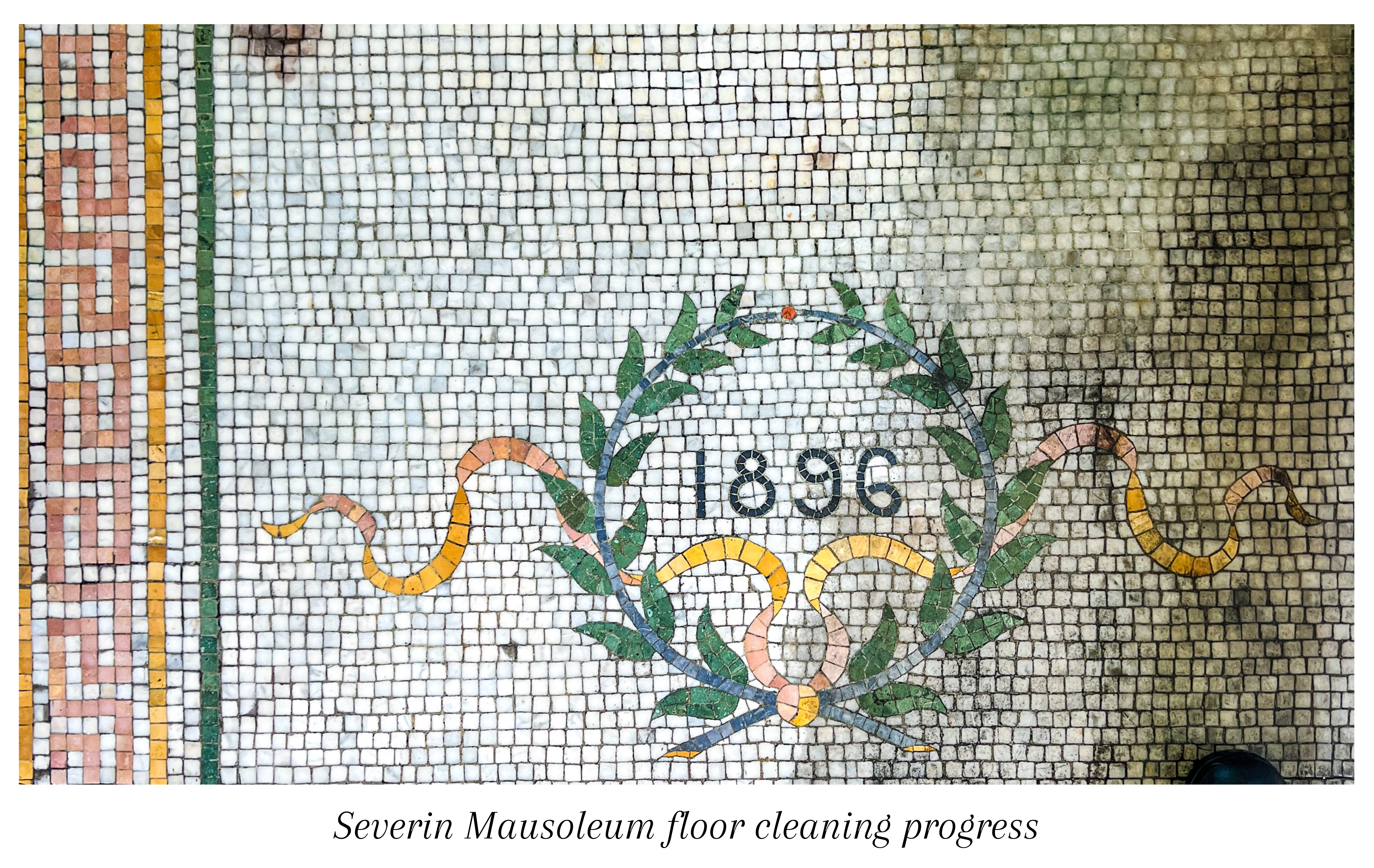 The Severin Mausoleum was designed in 1896. The first entombment was in 1897. In 1945, after the 10th entombment, the mausoleum door was sealed. Working with Head Construction of Dallas, TX, the Crown Hill Foundation staff chose the Severin Mausoleum because of the immediate need to stop water infiltration through the roof, joints and foundation. The damaged roof had moved significantly. While temporary fixes have been put in place to stop the movement, proper repair is needed to protect the structure. The gap created by the roof movement caused the interior of the structure to suffer from water infiltration. The preservation work on this mausoleum included resetting the roof, cleaning the stone structure, re-caulking missing mortar, cleaning the interior marble, re-securing the sagging marble ceiling, repairing and cleaning the damaged stained-glass window, sealing interior joints, and restoring the door lock and key. The before and after on this mausoleum is amazing. The cleaned floor revealed a beautiful marble tile mosaic, and the rehabilitated doors show off the travertine stone.
The Severin Mausoleum was designed in 1896. The first entombment was in 1897. In 1945, after the 10th entombment, the mausoleum door was sealed. Working with Head Construction of Dallas, TX, the Crown Hill Foundation staff chose the Severin Mausoleum because of the immediate need to stop water infiltration through the roof, joints and foundation. The damaged roof had moved significantly. While temporary fixes have been put in place to stop the movement, proper repair is needed to protect the structure. The gap created by the roof movement caused the interior of the structure to suffer from water infiltration. The preservation work on this mausoleum included resetting the roof, cleaning the stone structure, re-caulking missing mortar, cleaning the interior marble, re-securing the sagging marble ceiling, repairing and cleaning the damaged stained-glass window, sealing interior joints, and restoring the door lock and key. The before and after on this mausoleum is amazing. The cleaned floor revealed a beautiful marble tile mosaic, and the rehabilitated doors show off the travertine stone.
Frenzel/Dickson Family Mausoleum
 The Frenzel and Dickson families have a long history in Indianapolis. Otto Frenzel started his career in banking at Merchants National Bank and Trust Company, eventually serving as chairman of its Board. He was the sixth family member to serve as Merchant’s chief executive. George Dickson was co-owner of Dickson & Talbott, which operated a chain of theaters.
The Frenzel and Dickson families have a long history in Indianapolis. Otto Frenzel started his career in banking at Merchants National Bank and Trust Company, eventually serving as chairman of its Board. He was the sixth family member to serve as Merchant’s chief executive. George Dickson was co-owner of Dickson & Talbott, which operated a chain of theaters.
The 1903 Frenzel/Dickson mausoleum is still being utilized by the family, with over 15 entombments inside and interments surrounding the mausoleum. Working with the family, the structure was cleaned inside and out, interior and exterior joints re-caulked, the exterior window repaired, and new landscaping including curbing, plants and tree care was added. This work will insure the stability and beauty of the mausoleum for decades to come.
Fisher Family Mausoleum
 A co-founder of the Indianapolis 500, Carl Fisher had his family mausoleum built in 1916. His parents, son, brother, uncle, and a Royal Air Force pilot from New Zealand are all entombed in this Greek Revival structure, along with Fisher’s cremated remains. Because of his connection to the Indianapolis 500, it is an important stop on our Racing Legends Tour, located just up the hill from the Final Finish Line. The Fisher mausoleum received exterior cleaning and caulking of the interior and exterior joints by Head Construction. This will help alleviate any moisture infiltration. Our staff will monitor movement of the stones and joints on the interior to determine future work needs. The cremated remains of Carl and his brother Earl are in a glass and bronze table inside the mausoleum. The table will be removed, repaired to ensure its stability, and placed back in the mausoleum.
A co-founder of the Indianapolis 500, Carl Fisher had his family mausoleum built in 1916. His parents, son, brother, uncle, and a Royal Air Force pilot from New Zealand are all entombed in this Greek Revival structure, along with Fisher’s cremated remains. Because of his connection to the Indianapolis 500, it is an important stop on our Racing Legends Tour, located just up the hill from the Final Finish Line. The Fisher mausoleum received exterior cleaning and caulking of the interior and exterior joints by Head Construction. This will help alleviate any moisture infiltration. Our staff will monitor movement of the stones and joints on the interior to determine future work needs. The cremated remains of Carl and his brother Earl are in a glass and bronze table inside the mausoleum. The table will be removed, repaired to ensure its stability, and placed back in the mausoleum.
160 Stones for 160 Years
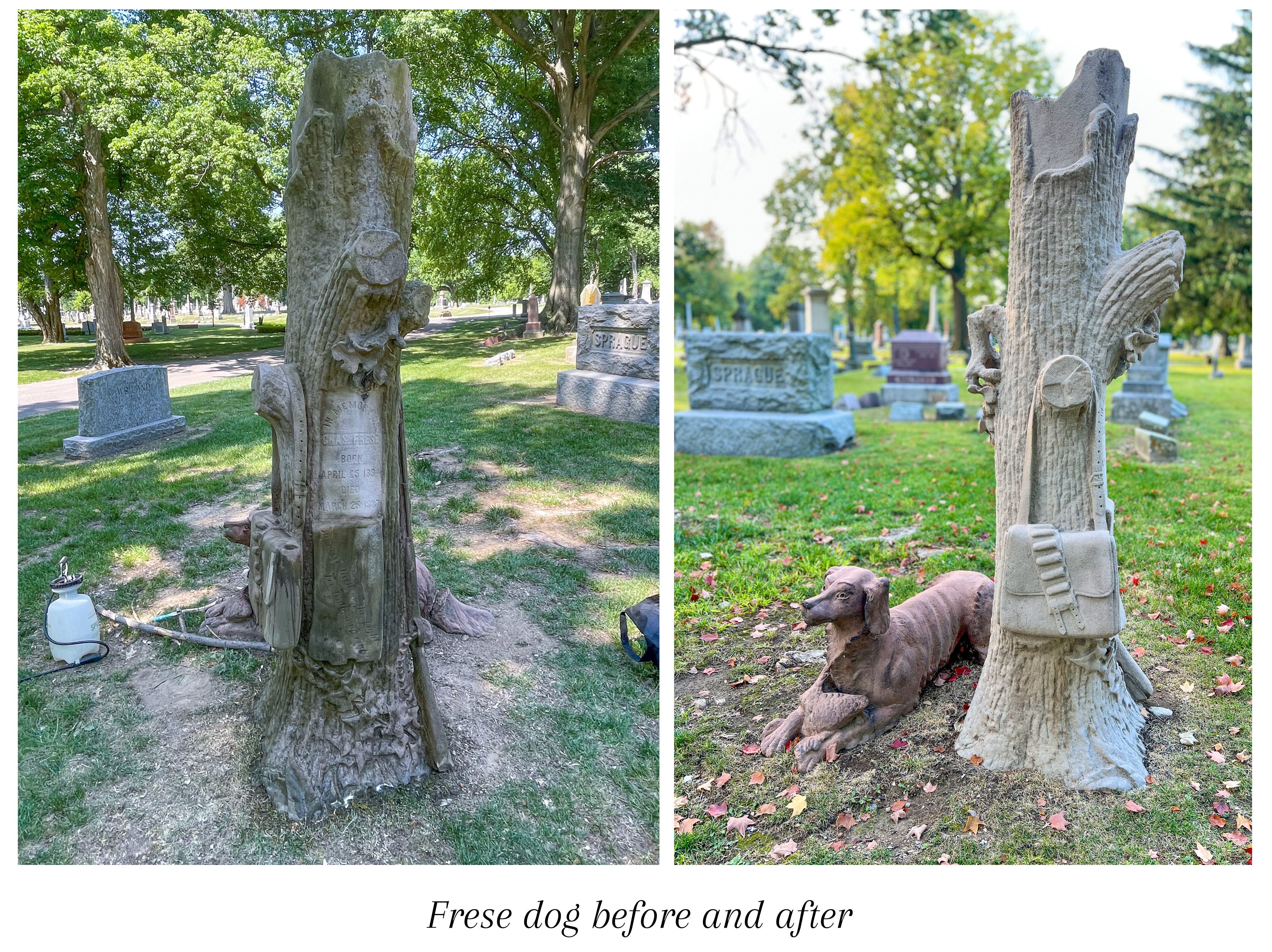
The 160th year also was the start of our volunteer program. With 555 acres, 250,000 tombstones, 11,000 trees, and countless educational tours, the work could not be done without the help of volunteers. Our three directors (historic preservation, arboretum and education) work with about 60 volunteers to get much of the work done on the property completed. The tombstone cleaning crew has been especially busy this summer.
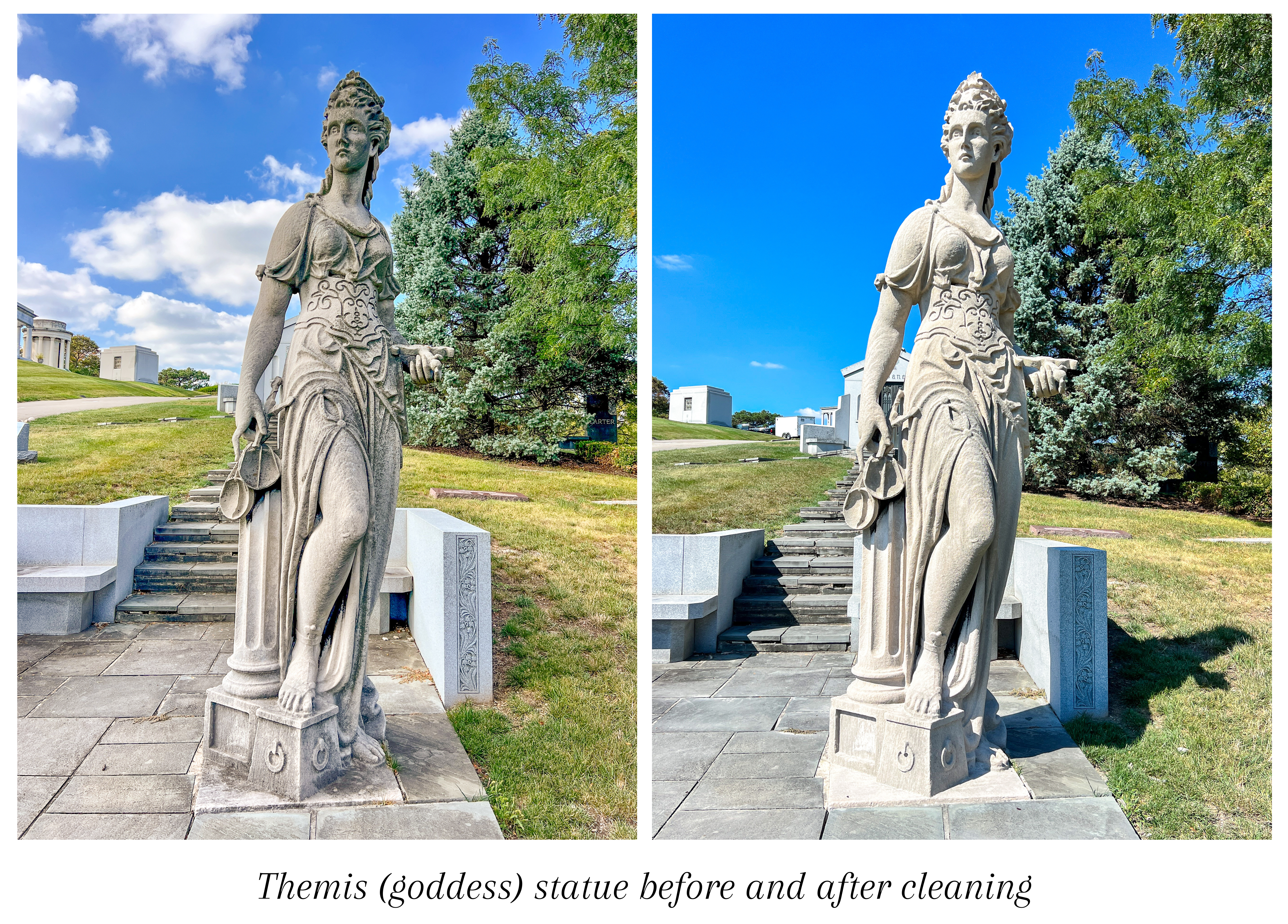 Every week, the crew of between seven and 12 people come out ready to scrub and scrub to clean up and preserve the stones of those buried here. The crew moves around the cemetery, working on a variety of stones selected because they are on certain projects, on sites frequently visited, or stones needing a little extra love.
Every week, the crew of between seven and 12 people come out ready to scrub and scrub to clean up and preserve the stones of those buried here. The crew moves around the cemetery, working on a variety of stones selected because they are on certain projects, on sites frequently visited, or stones needing a little extra love.
Since this was the first year of the volunteer crew, we were just training the group and not sure of exactly how many people would come out every week. We had a goal of cleaning 160 stones for the 160th anniversary, and our volunteers blew it out of the park. Over 250 stones have been cleaned. Some are iconic beauties, others are simple stones marking the life and death of infants, the working, and the poor. These stones have been cataloged and will go on a maintenance rotation so that we will not need to scrub the stones again. The less invasive cleaning that can be done, the longer the stones will hold up.
Here are a few stories of those whose stones we cleaned in 2023:
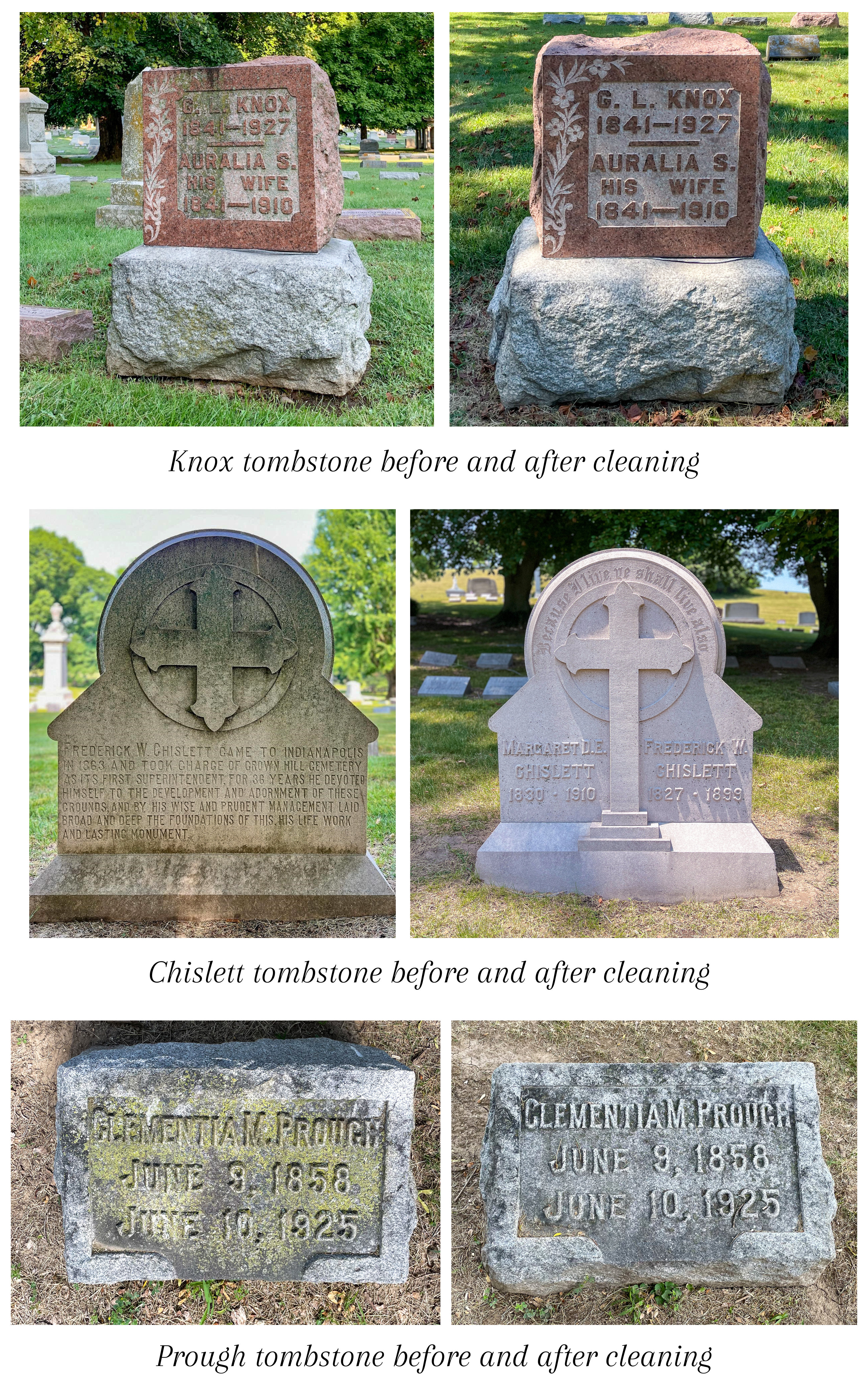 George Knox (1841–1927) was born and enslaved in Tennessee. During the Civil War, he escaped to the north and accompanied the 55th Indiana infantry Regiment. After moving to Indianapolis, Knox published The Indianapolis Freeman, was an activist and author, owned the Indianapolis Barber B.B.C., a Negro league baseball team, and was a leading citizen.
George Knox (1841–1927) was born and enslaved in Tennessee. During the Civil War, he escaped to the north and accompanied the 55th Indiana infantry Regiment. After moving to Indianapolis, Knox published The Indianapolis Freeman, was an activist and author, owned the Indianapolis Barber B.B.C., a Negro league baseball team, and was a leading citizen.
Frederick Chislett (1827-1899) After his father, Pittsburgh architect John Chislett, helped Crown Hill’s founders select the location of the cemetery the previous month, Frederick was hired on October 17, 1863, to be the 1st Superintendent of Crown Hill. He stayed 36 years until his death in 1899, when he was succeeded by his son, John. Frederick drained the marshy areas, built roads and planted trees to make Crown Hill a park-like cemetery.
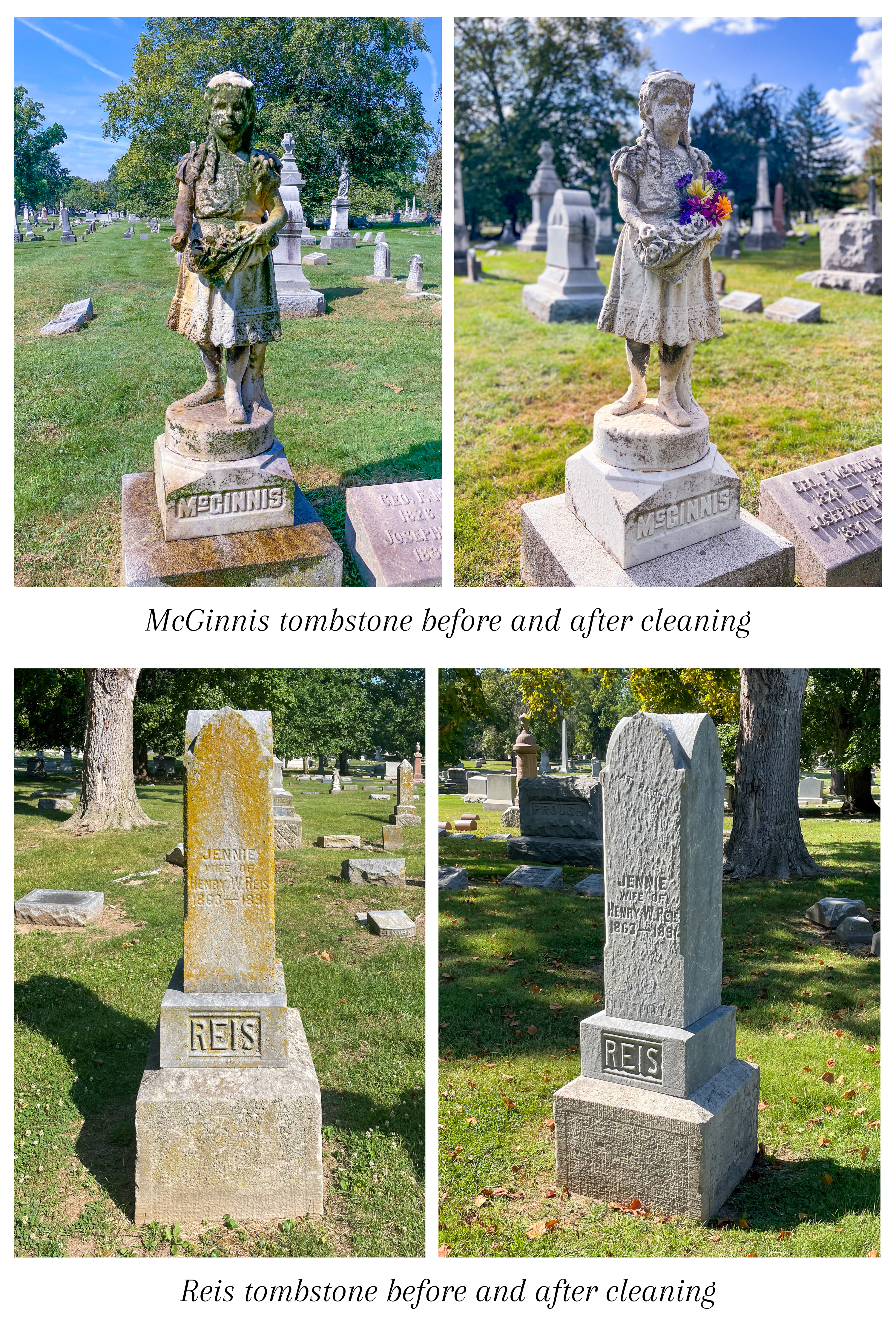
Clementia Prough (1858-1925) was a nurse attendant at the State Hospital for the Insane (Central State Hospital) and the nurse for poet James Whitcomb Riley after his stroke and until his death in 1916. She never married, lived with her siblings and died of arteriosclerosis just after her 67th birthday.
Mary Ella McGinnis (1869-1875) After Mary’s death at age five-and-a-half, her mother commissioned famous sculptor Lorado Taft to sculpt a likeness for a memorial. Not satisfied with his version, she sent a photo of Mary along with some clothes to an Italian sculptor to create the statue watching over her grave all these years. Following her mother’s example, visitors continue to leave flowers and teddy bears for Mary Ella.
Jennie L. Kiser Reis (1863-1891) was born into a Jewish family in Columbus, IN. She married Henry Reis in March 1889 in Columbus. Following Jennie’s birth of their son, she died of postpartum hemorrhage. Henry never remarried. He raised their son (Henry, Jr.), who became president of Old State Bank. Henry, Sr. is also buried in Crown Hill but does not have a stone. Only Jennie’s cleaned stone marks their family lot.
The cleanup of monuments will pause during the winter months, but we expect to resume starting next spring. We invite you to join us!

